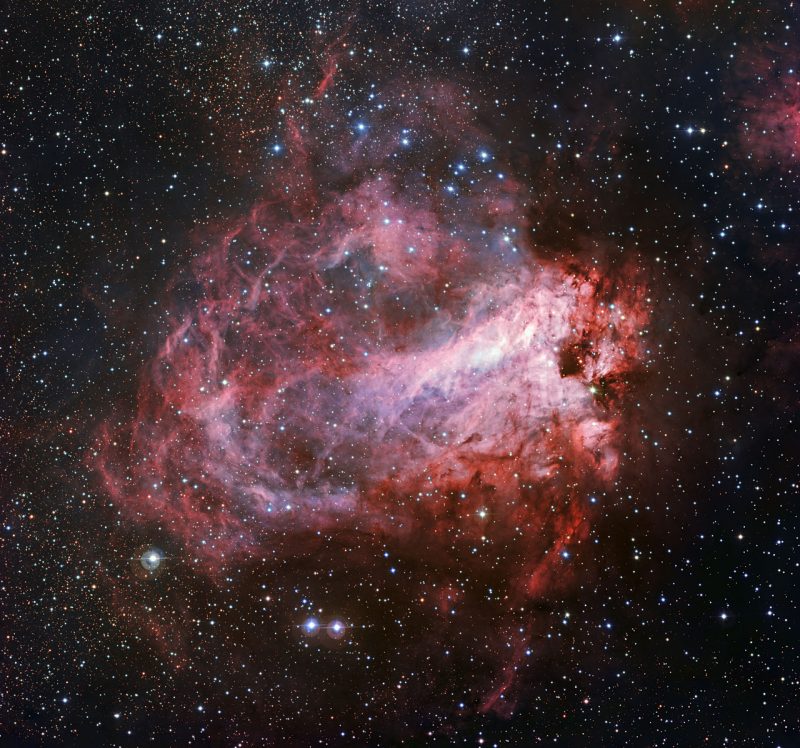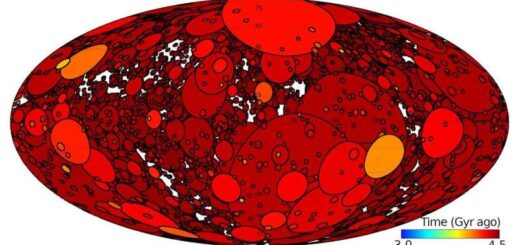The Omega Nebula Is A Star-Forming Region

The Omega Nebula – aka M17 – is barely visible to the unaided eye on a dark, moonless night. To see it, it’s best to use binoculars or low-power magnification on a telescope. The Omega Nebula is very near another prominent nebula, known as M16 or the Eagle Nebula. M16 is the home nebula of the famous Pillars of Creation image. In the sky, M16 and M17 appear as two closely-knit patches of haze. They fit readily within the same binocular field of view.
Both are found within the hazy starlit band of our Milky Way galaxy, as it crosses the sky on a northern summer evening. This region of the sky is crowded with deep-sky objects! Keep reading and see the chart at the bottom of this post.
How to see the Omega Nebula
If you want to see many deep-sky objects like M17, learn to recognize the constellation Sagittarius the Archer, with its famous Teapot asterism. The Teapot is located in the direction of the star-rich center of our Milky Way galaxy. It can help you find many beautiful star clusters and nebulae in this part of the sky. For example, from the legendary Teapot in Sagittarius, it’s an easy star-hop to M17 (the Omega Nebula) and its nearby companion nebula on the sky’s dome, M16.
From the Teapot, draw an imaginary line from the star Kaus Australis and pass just east (left) of the star Kaus Media to locate M16 and M17. These two nebulae are close together and located about one fist-width above the Teapot.
As seen from the Northern Hemisphere, the Teapot, M16 and M17 are summertime objects. They’re highest up when due south on late August evenings. At the same time, they’re wintertime objects from the Southern Hemisphere, where they are closer to overhead.
Star chart showing the Teapot, with an arrow drawn to M16 and M17.
How to star-hop from the famous Teapot asterism in the constellation Sagittarius to Messier 16 and Messier 17.
Very dense star field with two small pink patches at top and bottom.
Flickr user Mike Durkin captured this image of M16 and M17.
The nebula of many names
We know that objects in astronomy often have more than one name. They get their names from being observed and studied by various astronomers – by being listed in various catalogs – as the years pass. Amateur astronomers tend to call deep-sky objects like M16 and M17 by their “M” names, or Messier names. But all of thesee objects have proper names as well. M17, in particular, has at least five proper names — Omega Nebula, Horseshoe Nebula, Checkmark Nebula, Swan Nebula, and the Lobster Nebula. Why so many? Read more from Skyandtelescope.com: M17: The Nebula with too many names.
Science of M17
Like M16, the Omega Nebula M17 is a vast interstellar cloud of dust and gas giving birth to young, hot suns. It spans some 15 light-years in diameter. The cloud of interstellar matter of which this nebula is a part is roughly 40 light-years in diameter and has a mass of 30,000 solar masses. The total mass of the Omega Nebula is an estimated 800 solar masses.
The distance to the M17 Omega Nebula isn’t known with precision. There is little doubt that it lies farther away than the more brilliant Great Orion Nebula, the star-forming nebula that’s visible to the unaided eye in January and February. When you look at either M16 or M17, you’re gazing at deep-sky wonders in the next spiral arm inward: the Sagittarius arm of our Milky Way galaxy.
Astronomers think that the M17 Omega Nebula is around 5,000 light-years away. In contrast, the Orion Nebula resides within the Orion spiral arm (the same spiral arm as our solar system) at some 1,300 light-years distant. By the way, the local geometry of the Omega Nebula is similar to that of the Orion Nebula – except that the Omega Nebula is viewed edge-on – from the side – rather than face-on.
Very dense star field with white, C shaped nebula with a lighter bar across the middle.
VLT Survey Telescope image of the star-forming region Messier 17. Image via European Southern Observatory. Read more about this image.
Competing nebulae
There are many glorious deep-sky objects in this region of the heavens. Two of the most famous patches of nebulosity – M8 and M20 – also vie for your attention, and couple up together within the same binocular field.
Like M16 and M17, this pair resides in the Sagittarius arm and is found by star-hopping from The Teapot. Judge for yourself which pair of stellar nurseries makes the bigger splash!
Star chart showing Teapot, with 16 dots labeled as M-objects, mostly above the Teapot’s lid.
M16 and 17 are in a part of the sky crowded with star clusters and nebulae. Note that the Teapot in Sagittarius is located in the direction to the center of our Milky Way galaxy.
Bottom line: Barely visible to the unaided eye on a dark, moonless night, the Omega Nebula (Messier 17) is best seen through binoculars, or low power in a telescope.



 Creators of mankind
Creators of mankind Description of “Tall white aliens”
Description of “Tall white aliens” Where they came from?
Where they came from? About hostile civilizations
About hostile civilizations The war for the Earth
The war for the Earth “Tall white aliens” about eternal life
“Tall white aliens” about eternal life Video: “Nordic aliens”
Video: “Nordic aliens” Aliens
Aliens Alien encounters
Alien encounters The aliens base
The aliens base UFO
UFO Technology UFO
Technology UFO Underground civilization
Underground civilization Ancient alien artifacts
Ancient alien artifacts Military and UFO
Military and UFO Mysteries and hypotheses
Mysteries and hypotheses Scientific facts
Scientific facts


















